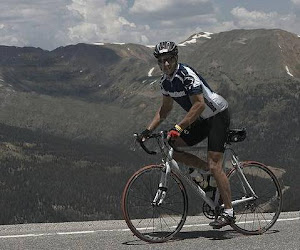
Many of us are dependent on our Local Bike Shop (LBS) for bike maintenance and repairs. There is nothing wrong with that. However, I believe you should know how to adjust your bikes derailleurs in EMERGENCIES. Who knows if during transport of your bike to a race something doesn't get knocked out of place and upon arrival/setup your bike either doesn't shift correctly or worse..the chain drops when you try to shift from the large chainring to the small...or vice versa. Trust me, this is the LAST thing you want happening BEFORE a big race. And yes, I understand that there are bike mechanics on-duty standing by (at most races) to help athletes in such EMERGENCIES...but NOT ALWAYS! Or, if they're there, there's a line that's 30 minutes long.
Adjustments to your bikes derailleurs takes about 2 minutes with just one tool: either a phillips-head (star) screwdriver for Shimano derailleurs or an allen head key/wrench for SRAM derailleurs. That's it! Your front and rear derailleurs have two screws on them (actually the rear has three, but I'm only going to address two)- a HIGH limit screw and a LOW limit screw. They are normally marked with an H or L. If not, generally, the top screw is the HIGH limit screw and the bottom one is the LOW limit screw. Makes sense to me.
Ok, so what does each screw do? Lets start with the rear derailleur. Specifically, let's start with the H limit screw. The H limit screw prevents the chain from either going past the smallest cog/sprocket (which is the highest gear...again makes sense) or onto the smallest cog/sprocket. A clockwise rotation of the H limit screw will prevent the chain from going past the smallest cog (or dropping off the cassette) and a counter-clockwise rotation just the opposite. Now, the L limit screw. The L limit screw prevents the chain from dropping into the spokes (from the large cog/sprocket which is the lowest gear- again makes sense) or from going onto the largest cog. A clockwise rotation of the L limit screw will prevent the chain from dropping into the spokes and a counter-clockwise rotation just the opposite. Pretty easy huh? In summary, clockwise rotation of a limit screw will prevent the chain from dropping off the cassette. Clockwise rotation of the H limit screw will prevent it from dropping off the High Gear (or small cog) and clockwise rotation of the L limit screw will prevent it from dropping off the Low Gear (or large cog).
Now, the front derailleur. Again, two screws: a H limit screw and a L limit screw. Can you guess how these work if they're consistent with how the back ones work? Well, they're similar (thank God). If you rotate the H limit screw clockwise it will prevent the chain from dropping off the big chainring (which is the High gear). Similarly, if you rotate the L limit screw clockwise it will prevent the chain from dropping off the small chainring. Turning these screws counter-clockwise will allow the chain to move more easily up/down from big to small (or small to big) chainrings.
An easy way to remember this is: if your chain is falling off your bike you need to turn one of the limit screws clockwise. If it's falling off the front...go to the front derailleur limit screws. If it's falling off the back...go to the rear derailleur limit screws. The H screw in the back makes adjustments for the High gear (little cog)...the H screw in the front makes adjustments for the High gear (big ring).
Makes sense huh? I think so. The only other thing I didn't mention is that when you're making adjustments to the rear derailleur's limit screws you do it with the proper cable tension. You make cable tension adjustments with the barrel adjuster.
Here's a link for more information (with photos) of rear derailleur adjustments: http://www.parktool.com/repair/readhowto.asp?id=64 and here's one for the front derailleur: http://www.parktool.com/repair/readhowto.asp?id=75





No comments:
Post a Comment